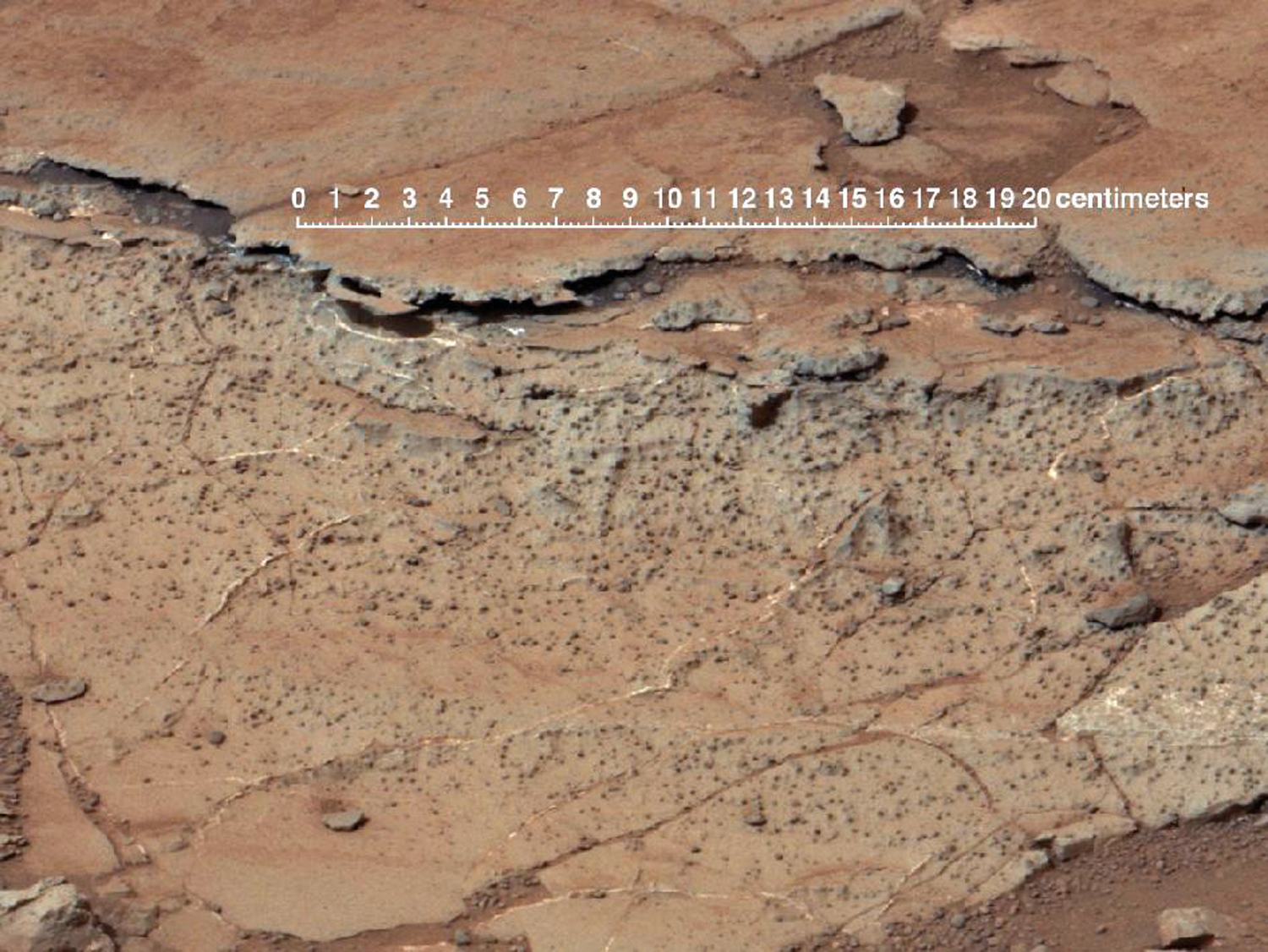Curiosity’s images show Earth-like soils on Mars, suggest microbial life
July 26, 2014

Rover image from Gale Crater reveals soil features similar to paleosols on Earth (credit: NASA)
Ancient fossilized soils potentially found deep inside an impact crater suggest microbial life.
Soil deep in a crater dating to some 3.7 billion years ago contains evidence that Mars was once much warmer and wetter, says University of Oregon geologist Gregory Retallack, based on recent images from Curiosity.
The images from the impact Gale Crater, Retallack said, reveal Earth-like soil profiles with cracked surfaces lined with sulfate, ellipsoidal hollows, and concentrations of sulfate, comparable with soils in Antarctic Dry Valleys and Chile’s Atacama Desert.
His analyses appear in a paper placed online by the journal Geology in advance of print in the September issue of the world’s top-ranked journal in the field.
Retallack, the paper’s lone author, studied mineral and chemical data published by researchers closely tied with the Curiosity mission. Retallack, professor of geological sciences and co-director of paleontology research at the UO Museum of Natural and Cultural History, is an internationally known expert on the recognition of paleosols — ancient fossilized soils contained in rocks.
“The pictures were the first clue, but then all the data really nailed it,” Retallack said. “The new data show clear chemical weathering trends, and clay accumulation at the expense of the mineral olivine, as expected in soils on Earth. Phosphorus depletion within the profiles is especially tantalizing, because it attributed to microbial activity on Earth.”
The ancient soils, he said, do not prove that Mars once contained life, but they do add to growing evidence that an early wetter and warmer Mars was more habitable than the planet has been in the past 3 billion years.
For a record of older life and soils on Mars, Retallack said, new missions will be needed to explore older and more clayey terrains.
Surface cracks in the deeply buried soils suggest typical soil clods. Vesicular hollows, or rounded holes, and sulfate concentrations, he said, are both features of desert soils on Earth.
“None of these features is seen in younger surface soils of Mars,” Retallack said. “The exploration of Mars, like that of other planetary bodies, commonly turns up unexpected discoveries, but it is equally unexpected to discover such familiar ground.”
The newly discovered soils provide more benign and habitable soil conditions than known before on Mars. Their dating to 3.7 billion years ago, he noted, puts them into a time of transition from “an early benign water cycle on Mars to the acidic and arid Mars of today.” Life on Earth is believed to have emerged and began diversifying about 3.5 billion years ago, but some scientists have theorized that potential evidence that might take life on Earth farther back was destroyed by plate tectonics, which did not occur on Mars.
Retallack noted that Steven Benner of the Westheimer Institute of Science and Technology in Florida has speculated that life is more likely to have originated on a soil planet like Mars than a water planet like Earth. In an email, Benner wrote that Retallack’s paper “shows not only soils that might be direct products of an early Martian life, but also the wet-dry cycles that many models require for the emergence of life.”
University of Oregon | University of Oregon Professor of Geological Sciences Gregory Retallack talks about his paper published in the journal Geology.
Abstract of Geology paper
Fluviolacustrine sediments filling Gale Crater on Mars show two levels of former exposure and weathering that provide new insights into late Noachian (3.7 ± 0.3 Ga) paleoenvironments of Mars. Diagnostic features of the two successive paleosols in the Sheepbed member include complex cracking patterns of surface dilation (peds and cutans), a clayey surface (A horizon), deep sand-filled cracks with vertical lamination (sand wedges), and replacive sulfate nodules aggregated into distinct bands (gypsic By horizon) above bedded sandy layers (sedimentary C horizon). Shallow gypsic horizon, periglacial sand wedges, and limited chemical weathering are evidence of a hyperarid frigid paleoclimate, and this alternated with wetter conditions for the lacustrine parent materials in Gale Crater during the late Noachian. Depletion of phosphorus, vesicular structure, and replacive gypsic horizons of these Martian paleosols are features of habitable microbial earth soils on Earth, and encourage further search for definitive evidence of early life on Mars.